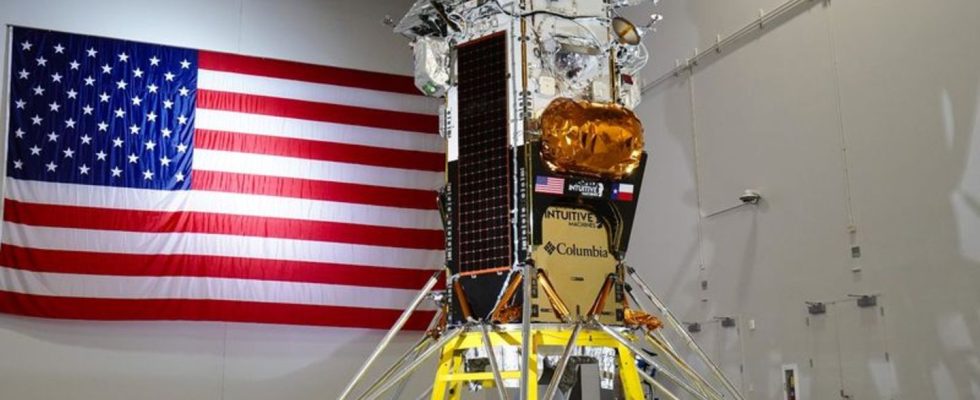Space travel
Another US company attempts first private moon landing
The US company Intuitive Machines wants to send the “Nova-C” lander to the moon. photo
© Nick Rios/Intuitive Machines/dpa
More and more countries and companies are pushing towards the moon. But landing on Earth’s satellite is not an easy task, as two attempts have already shown this year alone. Now the next one follows.
However, the launch at the Cape Canaveral spaceport using a “Falcon 9” rocket from technology billionaire Elon Musk’s space company SpaceX could still be delayed. Intuitive Machines hopes to land on the moon on February 22nd. It would be the first – albeit unmanned – US moon landing since the Apollo missions over 50 years ago and the first commercial landing on Earth’s satellite in space history.
Artist Jeff Koons involved
The “Nova-C” lander, nicknamed “Odysseus”, is about the size of an old-fashioned red British telephone box, has aluminum legs, weighs around 700 kilograms and can carry around 130 kilograms of cargo. NASA has occupied a large part of it with research equipment and other things, while commercial companies have secured the rest for their projects.
Artist Jeff Koons would like to send along 125 miniature stainless steel sculptures housed in a large cube. They are associated with people who have achieved significant achievements in history. “Odysseus” is expected to land in the southern region of the moon in a crater called “Malapert A”. After a possible successful touchdown, the lander would be operational for approximately seven days, according to its manufacturers.
However, moon landings are considered to be technically extremely demanding – and often go wrong. This year alone, two planned moon landings have turned out differently than hoped: The US company Astrobotic, based in Pittsburgh, sent off the “Peregrine” capsule in January. Shortly after takeoff there were problems due to a malfunction in the propulsion system.
The engineers managed to temporarily stabilize the capsule, but the goal of landing on the moon had to be abandoned. A few days later, “Peregrine” burned up in the Earth’s atmosphere.
Japan lands on the moon
Shortly afterwards, the lander “SLIM” (Smart Lander for Investigating Moon) from the Japanese space agency Jaxa touched down gently on the moon, but initially had problems with the energy supply. “SLIM” was only able to go into operation after a power outage that lasted for days. This makes Japan the fifth country – after the USA, Russia, China and India – to successfully land on the moon unmanned.
Last April, a Japanese company with a similar mission failed. Shortly after the planned landing time of “Hakuto-R” on the moon, the ispace company no longer received any data from the lander. The company assumes that he fell to the lunar surface in free fall. The reason she gave was an incorrect height calculation.
The upcoming test by Intuitive Machines is part of the “CLPS” (Commercial Lunar Payload Services) program of the US space agency NASA. With this program, NASA wants to accumulate as much knowledge as possible on its own way back to the moon, comparatively cheaply and efficiently, by awarding contracts for moon landings to private companies and working with them.
A total of around 2.6 billion dollars (around 2.4 billion euros) is budgeted for the “CLPS” program by 2028. Intuitive Machines will receive around $77 million for the now planned experiment. The company was founded in 2013 by, among others, the US-Iranian entrepreneur Kam Ghaffarian, who is also behind the company Axiom Space, which has just sent astronauts to the International Space Station again on a commercial mission.
Astrobotic’s “Peregrine” capsule was also part of the “CLPS” program. “Every success and every setback are opportunities to learn and grow,” said NASA manager Joel Kearns, commenting on the failed landing.
Back to the moon with “Artemis”
NASA wants to use the experience with “CLPS” primarily for its own “Artemis” program, which is intended to land people on the moon for the first time in more than half a century – including the first non-white person and the first woman . The long-term goal of “Artemis” is to establish a permanent lunar base as a basis for missions to Mars.
However, NASA had to postpone the manned lunar orbit “Artemis 2”, which was actually planned for November 2024, to September 2025 due to problems with the rocket and spacecraft, and the planned manned lunar landing “Artemis 3” to September 2026. There is competition from China, which will do so by 2030 wants to put people on the moon.

